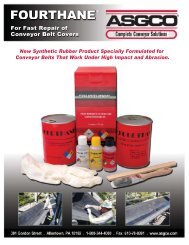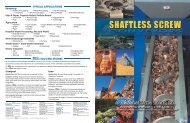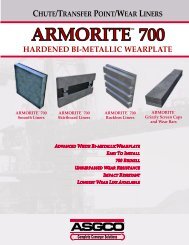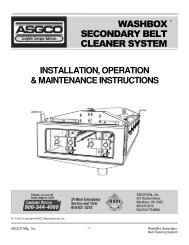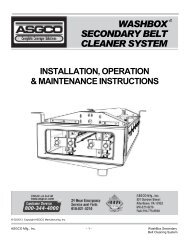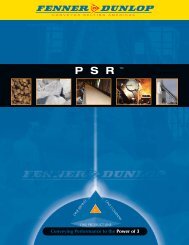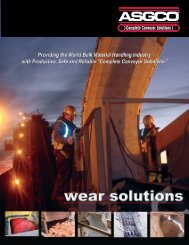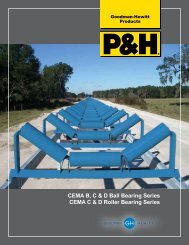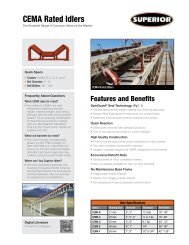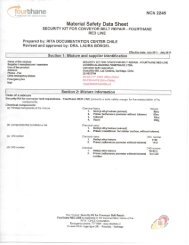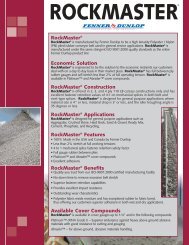3-DEM FLO-CONTROL
3 DEM Transfer Point Design Brochure2 - Asgco
3 DEM Transfer Point Design Brochure2 - Asgco
- No tags were found...
You also want an ePaper? Increase the reach of your titles
YUMPU automatically turns print PDFs into web optimized ePapers that Google loves.
®Transfer Point Design,Fabrication & Installationfor Improved Flo-Control3-<strong>DEM</strong> and<strong>FLO</strong>-<strong>CONTROL</strong> Increase Production CapabilitiesOptimize Belt Life & ComponentsMinimize Material SpillageReduce Need for Dust Control
3-<strong>DEM</strong> TRANSFER POINT DESIGNTransfer point design, fabrication and installations utilizing ASGCO's 3-<strong>DEM</strong>chute analysis program (Discrete Element Methods) is a revolutionary way tohandle granular and particulate material by streamlining the process from thepoint where material leaves the head pulley until it is deposited onto thereceiving conveyor for a more deliberate control of the material as it flows fromone conveyor to another. The performance of transfer chutes is an essentialpart to the productivity of the conveyor belt systems in the bulk solids industry.These techniques are easily applied to both existing and new installations,resulting in significant cost improvements and system efficiencies. Combinedwith our conveyor and material handling knowledge, engineering capabilitiesand complete turn-key installation services, we are able to make transfer pointproblems a thing of the past.BeforeAfterNotice the problem of all the stopped (red) particles that havecreated a chute-plugging problem at this transfer point.After the successful re-design using 3-<strong>DEM</strong> Chute Designprogram we were able to eliminate the plugging problem andhave a smooth controlled flow throughout the transfer point.The initial chute study produces a 3-D wireframe drawing of the existing chute and a 3-<strong>DEM</strong> flow simulation is run. Necessary designchanges are made to optimize the flow and reduce dusting, spillage and belt wear. We then run a new 3-<strong>DEM</strong> flow simulation showingmaterial flow and chute characteristics of the improved design. The key to a properly designed chute is steady, even and undisturbed materialvelocities, plus centering the material through the chutes and onto the receiving belts. Providing a uniform centered flow rate will greatlyincrease transfer point efficiencies, reduce belt wear, reduce back spillage and reduce material to chute impact wear and noise.There are ten steps that need to be completed to have a trouble-free transfer point.1.2.3.4.5.Take current drawings of existing transferand render them accurately in 3-D CAD andfill out Data Sheet.Identify chute geometry restriction andmanufacturing limitations.Identify customer project goals (i.e. flowrestrictions, dust emissions, optimize chuteand belt life).Identify material properties and developrepresentative particle description.Make design changes to chute geometry.6.7.8.9.10.Simulate performance using 3-<strong>DEM</strong> Chute Designsoftware.Evaluate simulation results and choose the bestdesign that meets the project goals.Detail the new design for manufacturing.Manufacture the new transfer point including otherconveyor components.Installation of the new transfer chute and otherconveyor components (i.e. belt cleaners, skirtingsystems and load zone beds or rollers).
<strong>FLO</strong>-<strong>CONTROL</strong> (HOOD & SPOON)The new chute can incorporate a new hood insert or a complete remodelingof the entire top and bottom of the transfer point. The head chute which willdirect the material down through a lower Spoon section that will direct theflow in the direction of belt travel and centered on the belt.FABRICATIONAdjustable material deflector (hood)lined with impact resistant ceramicliners are easily maintained todirect and concentrate the materialflow to the center of the chute.ASSEMBLYThe adjustable impact resistant ceramiclined “Spoon” bottom chute ensures that thematerial is “soft-loaded” at approximatelythe same speed as the receiving conveyor,is also properly center loaded on theconveyor, as well as designed to eliminateany flow restrictions that would cause thepotential for buildup.INSPECTIONThe objectives and benefits of using this type of design program are:• Increase Production Capabilities - by helping to eliminate spillage, chute plugging,conveyor belt wear, dust control and noise.• Optimize Life on Conveyor Belt and Components - by minimizing impact and topcover wear by using a soft or curved chute loading design.• Minimize Material Spillage - in the design by center loading the material, load thematerial at a uniform rate and optimize the material flow in direction of travel after thebelt is fully troughed.• Reduce the Need for Dust Control and Suppression - by minimizing the dust throughloading the material at a uniform rate through a curved soft loading design, maintainingskirting, internal wear liners and dust curtains staggered throughout.ON-SITEINSTALLATIONPERFECTLY CENTERED <strong>FLO</strong>WENTERINGHOODTIGHTMATERIALCOLUMN
®®By:Date:Please provide accurate AutoCAD Drawing showing all Conveyor-to-Conveyor/Transfer Point Dimensions.© 9/2008 ASGCO Manufacturing Co., Inc.301 Gordon Street • Allentown, PA 18102 • www.asgco.com • 1-800-344-4000 • FAX: 610-778-8991



